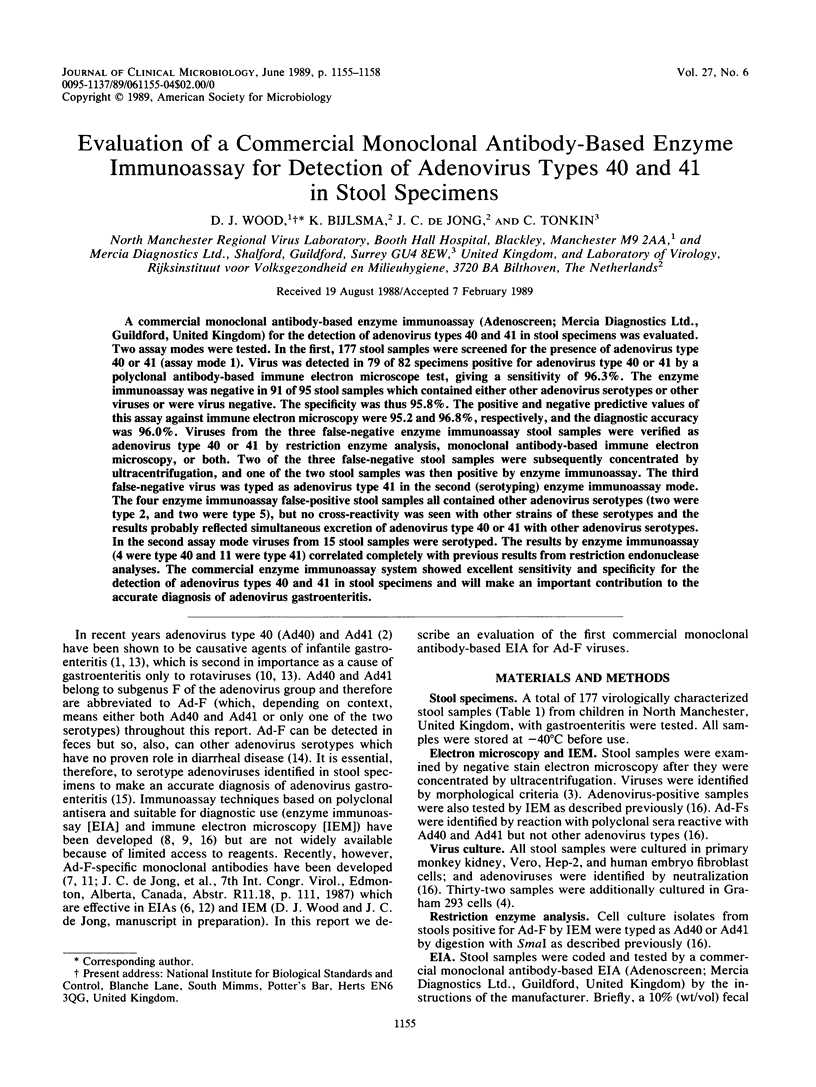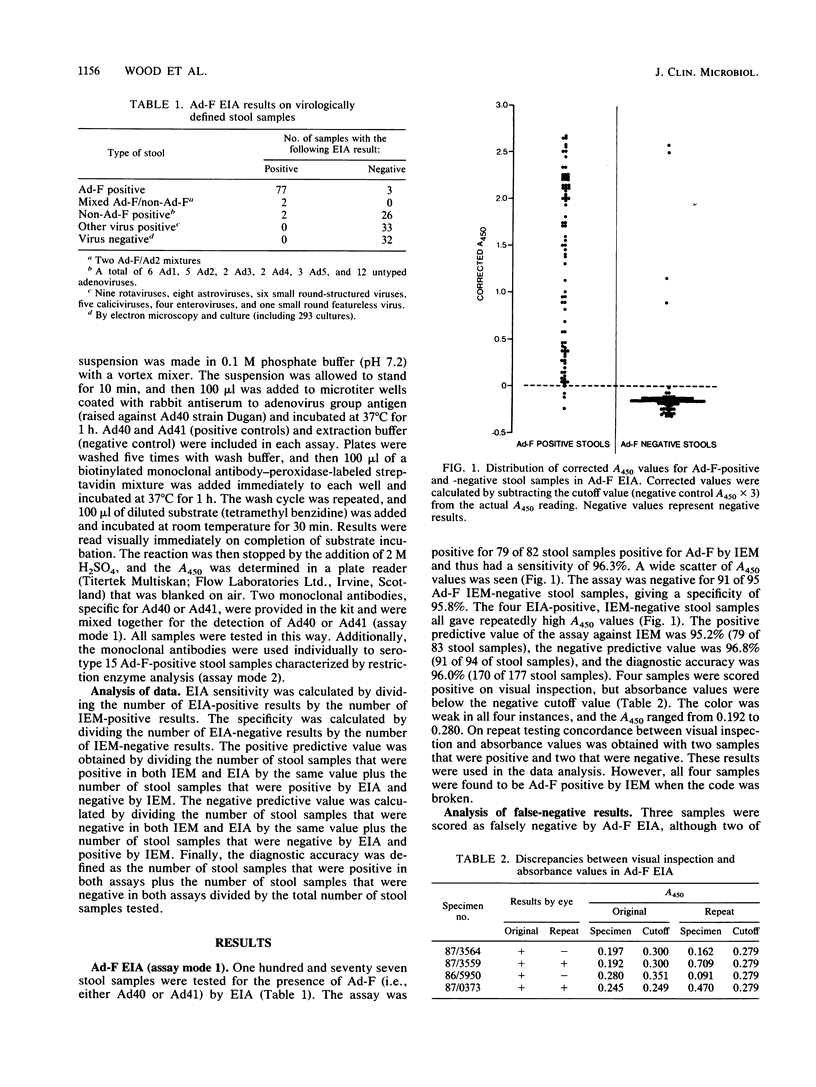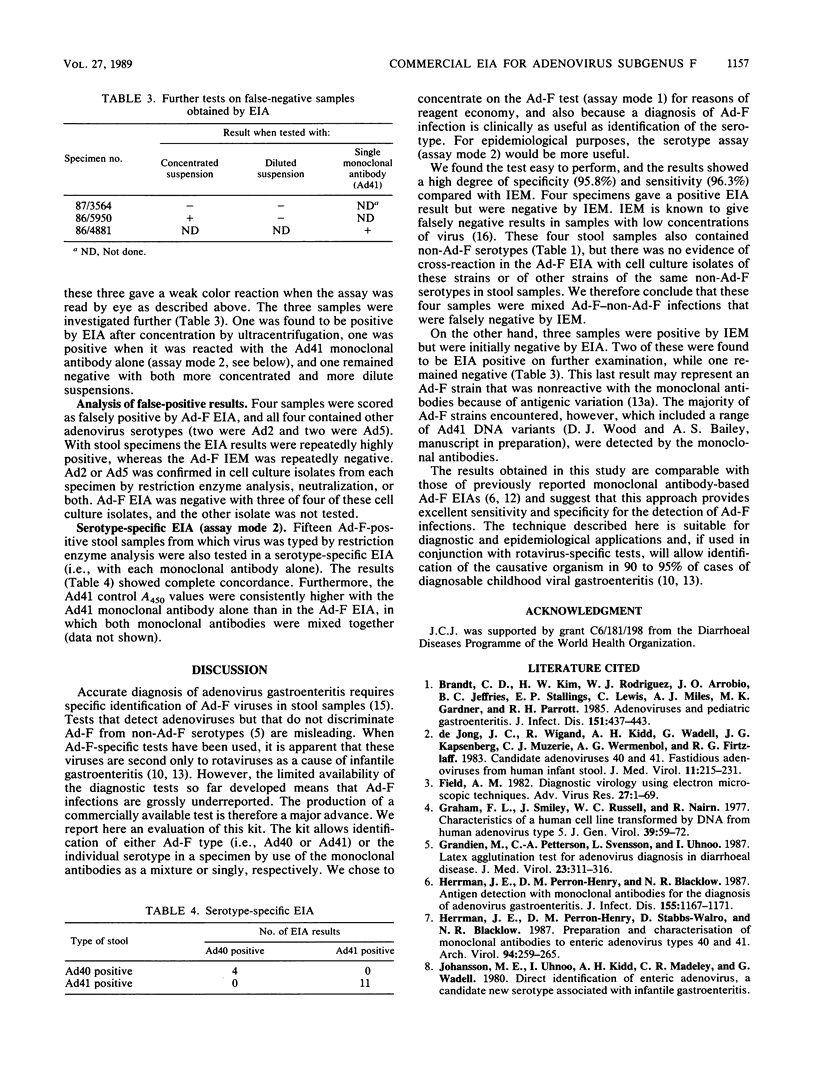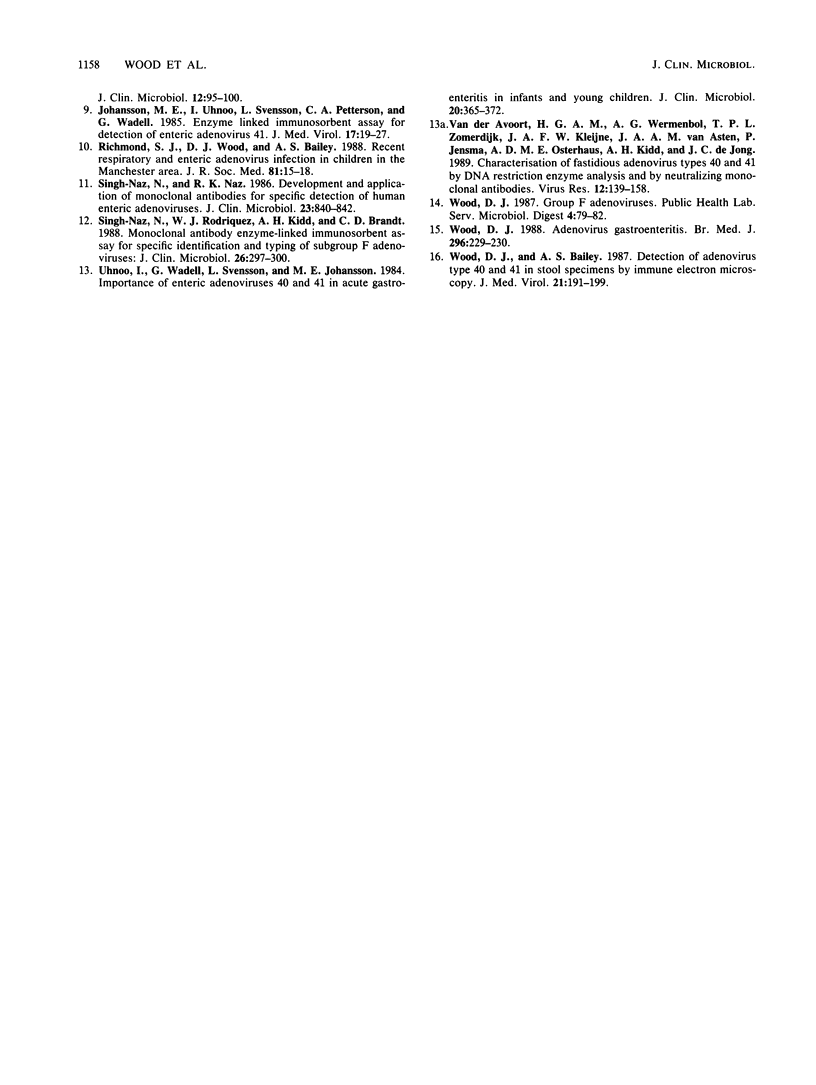Abstract
A commercial monoclonal antibody-based enzyme immunoassay (Adenoscreen; Mercia Diagnostics Ltd., Guildford, United Kingdom) for the detection of adenovirus types 40 and 41 in stool specimens was evaluated. Two assay modes were tested. In the first, 177 stool samples were screened for the presence of adenovirus type 40 or 41 (assay mode 1). Virus was detected in 79 of 82 specimens positive for adenovirus type 40 or 41 by a polyclonal antibody-based immune electron microscope test, giving a sensitivity of 96.3%. The enzyme immunoassay was negative in 91 of 95 stool samples which contained either other adenovirus serotypes or other viruses or were virus negative. The specificity was thus 95.8%. The positive and negative predictive values of this assay against immune electron microscopy were 95.2 and 96.8%, respectively, and the diagnostic accuracy was 96.0%. Viruses from the three false-negative enzyme immunoassay stool samples were verified as adenovirus type 40 or 41 by restriction enzyme analysis, monoclonal antibody-based immune electron microscopy, or both. Two of the three false-negative stool samples were subsequently concentrated by ultracentrifugation, and one of the two stool samples was then positive by enzyme immunoassay. The third false-negative virus was typed as adenovirus type 41 in the second (serotyping) enzyme immunoassay mode. The four enzyme immunoassay false-positive stool samples all contained other adenovirus serotypes (two were type 2, and two were type 5), but no cross-reactivity was seen with other strains of these serotypes and the results probably reflected simultaneous excretion of adenovirus type 40 or 41 with other adenovirus serotypes. In the second assay mode viruses from 15 stool samples were serotyped. The results by enzyme immunoassay (4 were type 40 and 11 were type 41) correlated completely with previous results from restriction endonuclease analyses. The commercial enzyme immunoassay system showed excellent sensitivity and specificity for the detection of adenovirus types 40 and 41 in stool specimens and will make an important contribution to the accurate diagnosis of adenovirus gastroenteritis.
Full text
PDF



Selected References
These references are in PubMed. This may not be the complete list of references from this article.
- Brandt C. D., Kim H. W., Rodriguez W. J., Arrobio J. O., Jeffries B. C., Stallings E. P., Lewis C., Miles A. J., Gardner M. K., Parrott R. H. Adenoviruses and pediatric gastroenteritis. J Infect Dis. 1985 Mar;151(3):437–443. doi: 10.1093/infdis/151.3.437. [DOI] [PubMed] [Google Scholar]
- Field A. M. Diagnostic virology using electron microscopic techniques. Adv Virus Res. 1982;27:1–69. doi: 10.1016/S0065-3527(08)60432-7. [DOI] [PMC free article] [PubMed] [Google Scholar]
- Graham F. L., Smiley J., Russell W. C., Nairn R. Characteristics of a human cell line transformed by DNA from human adenovirus type 5. J Gen Virol. 1977 Jul;36(1):59–74. doi: 10.1099/0022-1317-36-1-59. [DOI] [PubMed] [Google Scholar]
- Grandien M., Pettersson C. A., Svensson L., Uhnoo I. Latex agglutination test for adenovirus diagnosis in diarrheal disease. J Med Virol. 1987 Dec;23(4):311–316. doi: 10.1002/jmv.1890230402. [DOI] [PubMed] [Google Scholar]
- Herrmann J. E., Perron-Henry D. M., Blacklow N. R. Antigen detection with monoclonal antibodies for the diagnosis of adenovirus gastroenteritis. J Infect Dis. 1987 Jun;155(6):1167–1171. doi: 10.1093/infdis/155.6.1167. [DOI] [PubMed] [Google Scholar]
- Herrmann J. E., Perron-Henry D. M., Stobbs-Walro D., Blacklow N. R. Preparation and characterization of monoclonal antibodies to enteric adenovirus types 40 and 41. Arch Virol. 1987;94(3-4):259–265. doi: 10.1007/BF01310718. [DOI] [PubMed] [Google Scholar]
- Johansson M. E., Uhnoo I., Svensson L., Pettersson C. A., Wadell G. Enzyme-linked immunosorbent assay for detection of enteric adenovirus 41. J Med Virol. 1985 Sep;17(1):19–27. doi: 10.1002/jmv.1890170104. [DOI] [PubMed] [Google Scholar]
- Richmond S. J., Wood D. J., Bailey A. S. Recent respiratory and enteric adenovirus infection in children in the Manchester area. J R Soc Med. 1988 Jan;81(1):15–18. doi: 10.1177/014107688808100108. [DOI] [PMC free article] [PubMed] [Google Scholar]
- Singh-Naz N., Naz R. K. Development and application of monoclonal antibodies for specific detection of human enteric adenoviruses. J Clin Microbiol. 1986 May;23(5):840–842. doi: 10.1128/jcm.23.5.840-842.1986. [DOI] [PMC free article] [PubMed] [Google Scholar]
- Singh-Naz N., Rodriguez W. J., Kidd A. H., Brandt C. D. Monoclonal antibody enzyme-linked immunosorbent assay for specific identification and typing of subgroup F adenoviruses. J Clin Microbiol. 1988 Feb;26(2):297–300. doi: 10.1128/jcm.26.2.297-300.1988. [DOI] [PMC free article] [PubMed] [Google Scholar]
- Uhnoo I., Wadell G., Svensson L., Johansson M. E. Importance of enteric adenoviruses 40 and 41 in acute gastroenteritis in infants and young children. J Clin Microbiol. 1984 Sep;20(3):365–372. doi: 10.1128/jcm.20.3.365-372.1984. [DOI] [PMC free article] [PubMed] [Google Scholar]
- Wood D. J. Adenovirus gastroenteritis. Br Med J (Clin Res Ed) 1988 Jan 23;296(6617):229–230. doi: 10.1136/bmj.296.6617.229-a. [DOI] [PMC free article] [PubMed] [Google Scholar]
- Wood D. J., Bailey A. S. Detection of adenovirus types 40 and 41 in stool specimens by immune electron microscopy. J Med Virol. 1987 Feb;21(2):191–199. doi: 10.1002/jmv.1890210211. [DOI] [PubMed] [Google Scholar]
- de Jong J. C., Wigand R., Kidd A. H., Wadell G., Kapsenberg J. G., Muzerie C. J., Wermenbol A. G., Firtzlaff R. G. Candidate adenoviruses 40 and 41: fastidious adenoviruses from human infant stool. J Med Virol. 1983;11(3):215–231. doi: 10.1002/jmv.1890110305. [DOI] [PubMed] [Google Scholar]
- van der Avoort H. G., Wermenbol A. G., Zomerdijk T. P., Kleijne J. A., van Asten J. A., Jensma P., Osterhaus A. D., Kidd A. H., de Jong J. C. Characterization of fastidious adenovirus types 40 and 41 by DNA restriction enzyme analysis and by neutralizing monoclonal antibodies. Virus Res. 1989 Feb;12(2):139–157. doi: 10.1016/0168-1702(89)90060-9. [DOI] [PubMed] [Google Scholar]


